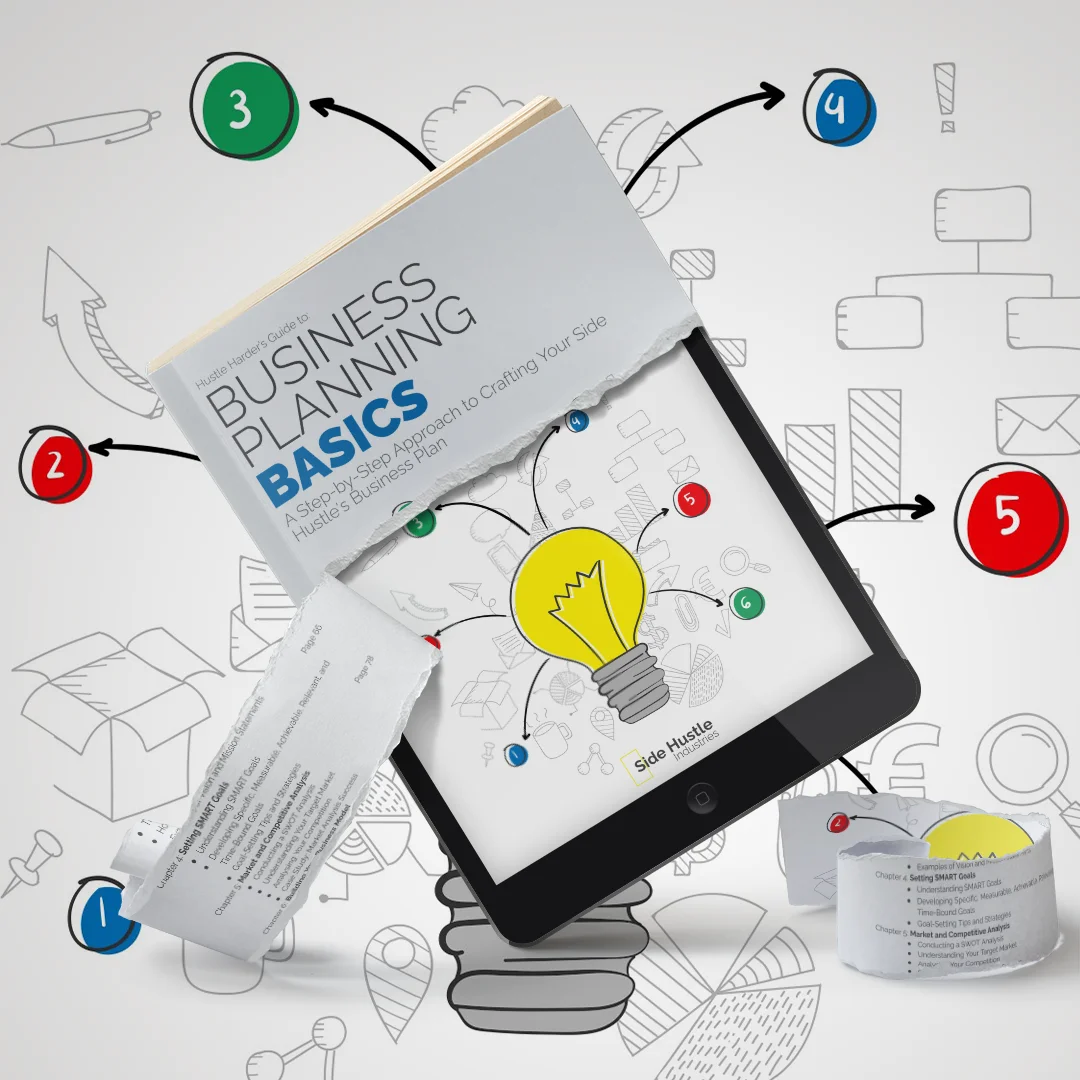
Market research and analysis are the cornerstones of a successful side hustle. They provide you with invaluable insights into your target audience, competition, and industry trends. With this knowledge, you can make informed decisions, identify opportunities, and reduce the risks associated with entrepreneurship. In this blog, we will explore the significance of market research and analysis, guide you through the process of conducting effective research, and offer practical tips for extracting actionable insights that can drive your side hustle to success.
The Significance of Market Research and Analysis
Effective market research and analysis offer numerous benefits to aspiring and seasoned entrepreneurs:
1. Understanding Your Target Audience:
Market research helps you gain a deep understanding of your target audience. You can identify their needs, preferences, and pain points, enabling you to tailor your offerings to meet their specific requirements.
2. Minimising Risk:
By thoroughly researching the market, you can uncover potential challenges and threats early on. This allows you to develop strategies to mitigate risks and make informed decisions.
3. Identifying Opportunities:
Market analysis helps you identify gaps, unmet needs, or underserved segments within your industry. These gaps represent opportunities for you to provide value and differentiate your business.
4. Competitor Assessment:
Researching competitors allows you to understand their strengths and weaknesses. This knowledge helps you position your business effectively and potentially capture market share.
5. Pricing Strategy:
Market research assists in setting competitive and profitable pricing. You can determine what customers are willing to pay for your products or services.
6. Marketing and Messaging:
Knowing your target audience’s preferences enables you to create marketing campaigns and messaging that resonate with them. This can lead to more effective marketing and higher conversion rates.
7. Growth and Expansion:
As your side hustle grows, market research and analysis are crucial for identifying new opportunities, expanding your customer base, and scaling your business.
8. Data-Driven Decisions:
Market data provides the foundation for making data-driven decisions, which can lead to more successful and sustainable growth.

The Process of Market Research and Analysis
Effective market research and analysis involve a structured and systematic approach. Here’s a step-by-step guide to help you navigate the process:
1. Define Your Research Goals:
Start by defining clear and specific research objectives. What do you want to learn or achieve through your research? For example, you might want to understand customer preferences or assess the size of your target market.
2. Choose Research Methods:
Select the research methods that align with your goals. Common research methods include surveys, interviews, focus groups, observation, and data analysis.
3. Collect Data:
Execute your chosen research methods to gather data. Ensure that your data collection process is well-organised and follows a predetermined plan. Keep detailed records.
4. Analyze Data:
Once you’ve collected data, analyse it to extract meaningful insights. Look for patterns, trends, and correlations in the data that can inform your business decisions.
5. Assess Competitors:
Conduct a thorough analysis of your competitors. Identify who they are, what they offer, and how they market their products or services. Assess their strengths and weaknesses.
6. Identify Industry Trends:
Stay updated on industry trends and developments. Follow relevant news sources, attend industry conferences, and participate in forums or social media discussions to understand the current landscape.
7. Profile Your Target Audience:
Create detailed customer profiles for your target audience. Include demographics, psychographics, preferences, behaviours, and pain points. This information is vital for crafting marketing strategies.
(See Hustle Harder’s Guide to: BUYER PERSONAS – A Comprehensive Guide to Creating Effective Buyer Personas for Your Side Hustle.)
8. Evaluate Pricing and Profitability:
Assess pricing strategies within your industry and analyse the profitability of your business model. Determine how much customers are willing to pay for your products or services.
9. Test and Validate:
If possible, test your products or services with a small group of potential customers. Gather feedback and validate your assumptions. Use this data to make improvements.
10. Report and Action Plan:
Compile your research findings into a comprehensive report. This report should outline your insights, conclusions, and recommended actions based on the research.

Real-Life Example: Market Research and Analysis
Imagine you’re planning to start a side hustle in the organic skincare industry. Here’s how you would approach market research and analysis:
Define Your Research Goals:
Your research goal is to understand the demand for organic skincare products, identify the target audience, and assess the competitive landscape in the organic skincare market.
Choose Research Methods:
You decide to use a combination of online surveys and competitor analysis. Surveys will help you gather customer preferences, and competitor analysis will provide insights into the current market players.
Collect Data:
You design an online survey to collect data from potential customers. The survey includes questions about their skincare habits, preferences, and willingness to pay for organic skincare products. Simultaneously, you gather information about established organic skincare brands by researching their product offerings, pricing, and marketing strategies.
Analyze Data:
After collecting survey responses, you analyse the data to identify common trends and preferences. For instance, you discover that many respondents prefer skincare products with minimal ingredients and recyclable packaging.
Assess Competitors:
Through competitor analysis, you identify several well-known organic skincare brands. You observe that these brands focus on natural ingredients, eco-friendly packaging, and cruelty-free testing practices.
Identify Industry Trends:
You follow industry news and notice that there is a growing trend in sustainable and eco-friendly skincare products. This aligns with your findings from customer surveys and competitor analysis.
Profile Your Target Audience:
Customer profiles indicate that your target audience consists of environmentally conscious individuals who prioritise skincare products that align with their values.
Evaluate Pricing and Profitability:
Pricing analysis reveals that organic skincare products are priced at a premium compared to conventional skincare. Customers seem willing to pay more for products that offer quality and sustainability.
Test and Validate:
You create a small batch of organic skincare products based on the preferences identified in your research. You offer these products to a select group of potential customers and gather feedback on the quality and packaging. Feedback is overwhelmingly positive, confirming your research findings.
Report and Action Plan:
You compile your research findings into a report that outlines your target audience, pricing strategy, and product development plans. The report also includes recommendations for marketing strategies that emphasise the eco-friendly and sustainable aspects of your products.
By following this process, you’ve gained a deep understanding of the organic skincare market, enabling you to make informed decisions and develop a strong business strategy.
Staying Current and Adapting
Market research and analysis are not one-time tasks. To remain competitive and adaptive in the dynamic world of entrepreneurship, it’s essential to stay current with industry trends and evolving customer preferences. Regularly update your research and analysis to ensure that your business strategies continue to align with market demands.
Staying current can involve:
- Continuous Data Gathering: Keep collecting data on customer preferences, market trends, and competitive insights. Use customer feedback, surveys, and industry reports to stay informed.
- Monitoring Competitors: Regularly assess your competitors to understand their strategies and identify any new market entrants. Consider how your business can maintain its competitive edge.
- Adapting Strategies: Be willing to adapt your strategies based on new data and insights. If market trends shift, adjust your offerings or marketing strategies accordingly.
- Innovation and Expansion: Look for opportunities to innovate or expand your product or service offerings in response to changing customer needs.
- Feedback Loop: Maintain a feedback loop with your customers. Actively seek their input and listen to their suggestions, as this can help you improve your offerings and stay relevant.
Market research and analysis are fundamental to the success of your side hustle. They provide the insights you need to understand your target audience, assess the competitive landscape, and identify opportunities for growth. By following a systematic process of research, analysis, and validation, you can make informed decisions and develop strategies that align with market demands. It’s important to remember that market research is an ongoing endeavor; staying current and adaptable is key to long-term success.

*Also available on Amazon in Kindle, Soft Cover & Hard Cover formats. —> Click Here.
